Grumman Guardian
| Serial Number: Unknown | Date of Sinking: March 30, 1954 | |||
| Other Names: AF-2W | Cause of Sinking: Crash/Ditching | |||
| Rig/Type: Navy Anti-Submarine Carrier Aircraft | Cargo: None | |||
| Length: 43' 4" | Wingspan: 60' 8" | Tons: N/A | Location: Santa Cruz Island | |
| Construction: Aluminum | Depth: 50'-60' | Visibility: 20-60 Feet | ||
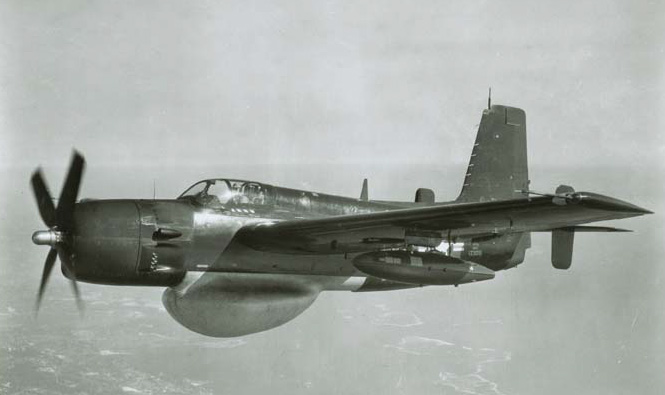
An AF-2W in flight. The radome is clearly visible under the fuselage along with drop tanks under the wings.
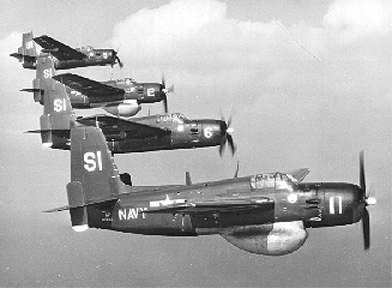 |
A squadron of Guardians in flight. The closest plane(#11) is a AF-2W (hunter), the next plane (#6) is a AF-2F (killer).
|
The Grumman Guardian was developed as World War II came to a close. The Navy, realizing a need for anti-submarine aircraft, ordered Grumman Aerospace Corporation to modify the developing XTB3F-1 bomber, a potential successor to the famed TBF/TBM Avenger. The new plane was to be classified as “hunter-killer” carrier based anti-submarine (ASW) aircraft. The AF-2W (hunter) and the AF-2S (killer) were built from November 1949 until April 1953. Designed to work in pairs, the AF-2W carried a radome under the fuselage, housing a large (APS-20) search radar used to locate submarines and the AF-2S pinpointed the submarine with a smaller starboard wing mounted radar (APS-30) or if necessary, illuminated the target with a port wing searchlight. The AF-2S carried depth charges and bombs in the weapons bay and wing mounted rockets.
During the production run some 387 Guardians (including prototypes) were built. They included 193 AF-2S, 153 AF-2W, 25 AF3S and 16 AF-3W. The AF-3 design included a Magnetic Anomaly Detector (MAD) boom affixed to the starboard side of the fuselage.
By early 1953, Guardians began to be phased out of front line Navy squadrons in favor of the S2F-1 Tracker, a combined hunter- killer aircraft. August 31, 1955 saw the end of the last operational active Navy squadron. The Guardians had slowly been transferred to U.S. Navy Reserve squadrons and mothballed.
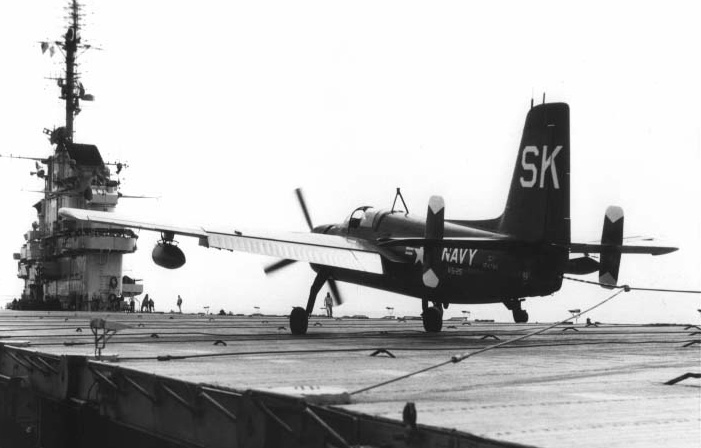
An AF-2S (killer) from squadron VS-25 catches a wire aboard the aircraft carrier U.S.S. Essex (CV 9) in 1952, from this perspective the immense size of the plane is apparent.
The Guardian was a large plane with a wingspan of 60 feet 8 inches. It stood 16 feet 2 inches off the ground, measured 43 feet 4 inches in length and weighed 14,580 pounds empty. Fully loaded, the plane could weigh as much as 25,500 pounds for the AF-2S and 22,500 pounds for the AF-2W. The AF-2W carried a crew of 4 (1 pilot in the forward cockpit, a radar operator, relief radar operator and a radio-countermeasure operator in the aft cockpit). The AF-2S carried a crew of 2 (1 pilot in the forward cockpit and a weapons/radar operator in the aft cockpit). The Guardians were powered by a single 4-bladed propeller driven by a Pratt & Whitney R-2800-48W, 2400 hp radial engine.
On March 30, 1954, Lt. John W. Miller was piloting this particular plane with his two crew, Bill Burris and Walter G. Brown. Their mission was to located a missing jet aircraft. When engine trouble, the plane was successfully ditched in the water near the shore and three men reached safety on the sandy beach 150 yards away on the south side of Santa Cruz Island, east of Gull Island. Once on shore a parachute was spread out on the sand and distress flares fired. A rescue helicopter picked them up that afternoon.
Diving the Grumman Guardian
Today, the Guardian sits upright on the bottom in 60 feet of water. The landing gear is retracted, the plane is intact except for the propeller, which lies 75 feet away in the sand, its blades bent backwards. The radome is buried in the sand and in unknown condition. The plane faces an easterly direction and is in very good condition with many features easily recognizable. The rudder and ailerons have broken away and there are metal electronics boxes visible in the aft cockpit. The starboard wing is off the bottom approximately 4 feet at the tip and the port wing lies in the sand. There are areas where the aluminum skin is devoid of marine growth and shiny, while in other areas it has corroded away, fortunately about 85% remains. The landing gear is visible from the top of the port wing, while the starboard landing gear is under the wing. Engine details are sharp despite the marine growth that covers the plane. The plane attracts a wide variety of fish and in its time on the bottom has become a living reef.
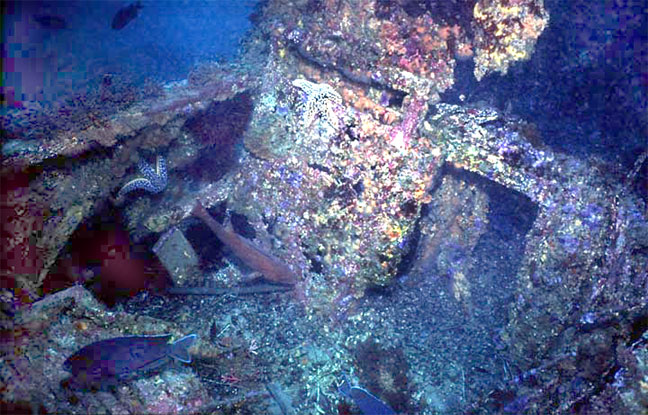
A view of the rear seat. This station was manned by the radar operator. A second relief operator faces rearward in the lower right corner of the photograph. The sonobuoy operator sits facing forward behind the rectangular hatchway to the right of the radar operators chair.
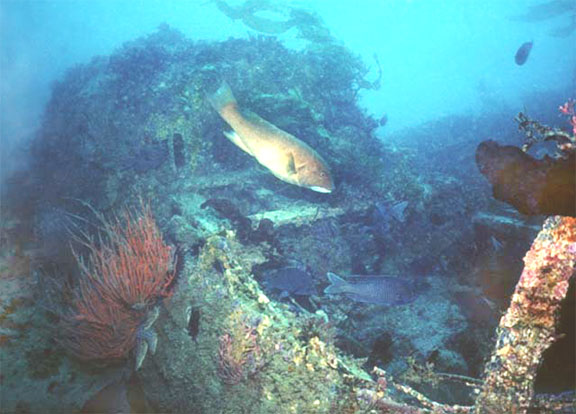
A view of the port side of the aircraft looking forward. The open space is the radar operators station. The radar controls would rest on the framework in the background.
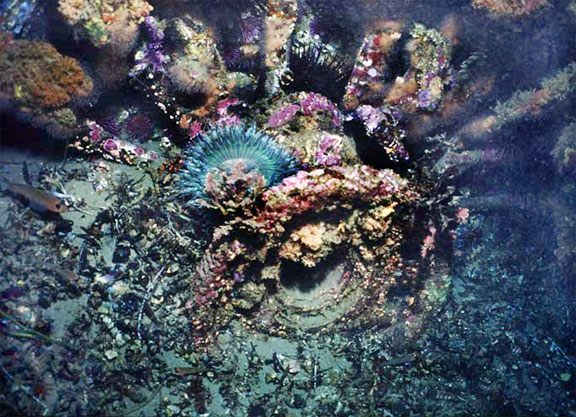
The front of the engine resting in the sand. The prop has broken away but would have been connected to hub. The radial engine arms are still visible.
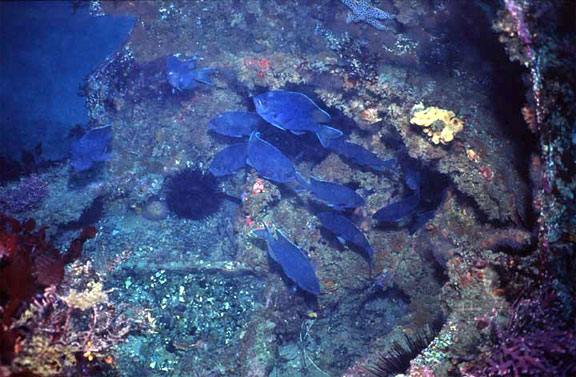
The remains of the cockpit. The stick is barely visible at the tail of the lowest blue fish, just to the right of the sea urchin. The cockpit glass shows in the far right of the photo.
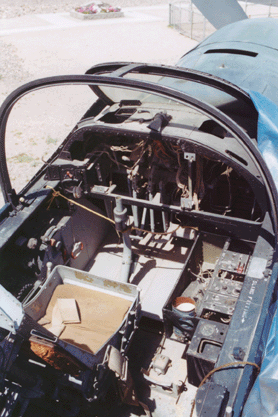
A similar view of the cockpit from one of the few surviving Guardian aircraft, this is an AF-2S (killer ) being restored at the Arizona Wing of the Confederate Air Force. Sadly, there are no know examples of the AF-2W (hunter) remaining.
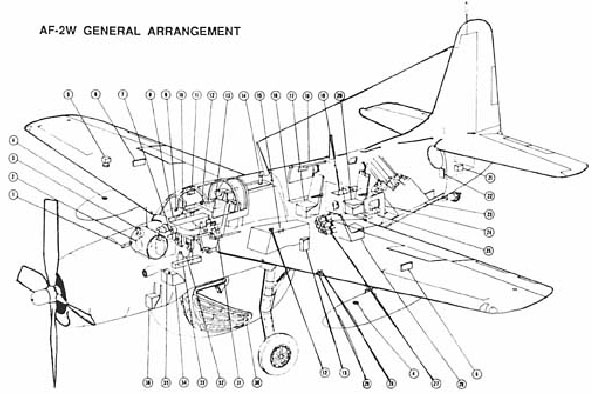
A wire frame diagram of an AF-2W
| Like to learn more about this wreck? Visit our Guest Page to submit your inquiry. |
